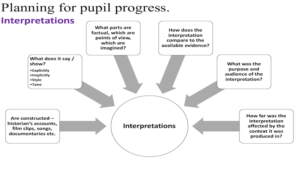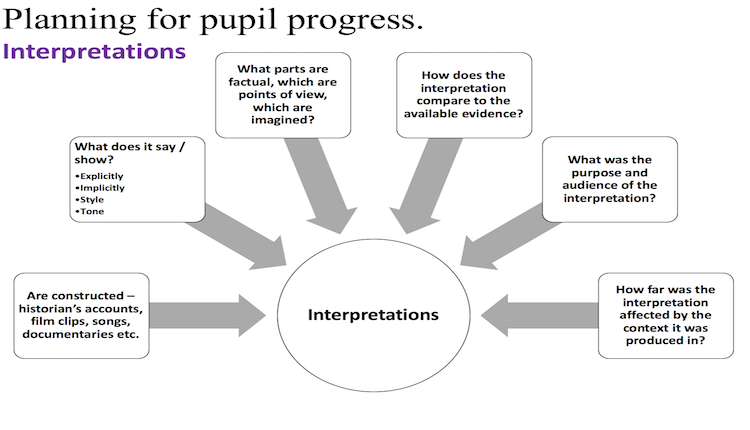As stated in a previous blog, the teaching of historical interpretations is a crucial element of developing your student’s historical thinking.
If you want to play the game where your teaching is solely about getting kids to ‘pass the test’, to do well in the 9-1 GCSEs then this is an area of conceptual thinking that you need your students to really grasp. After all, the focus of the AO4 is on interpretations. Many teachers have expressed a concern with how to approach this.
Exam hoop jumping aside, for many years I have felt that helping kids come to terms with interpretations is one of the most important aspects of my job as a history teacher.
Without realising, when I look back at the different curricula I have developed at KS3 and KS4 I ensured that kids ‘bumped into interpretations’ as often as possible – thanks Christine Counsell for the phrase. Although originally it was used with reference to first order concepts in a reply to an earlier blog post.
In past curriculum models enquiries either majored in interpretations, or, they minored in it. Where, for example a causation question would turn in the end into an interpretations one.
What should we focus on when we teach interpretations?
If you go back to the scholarship on this, there is a wealth of literature. McAleavy and Counsell in particular put forward a good model of what to focus on when it comes to interpretations. Here is an adapted model.
 This has really been my guiding light over the years. My view is the more elements of this diagram we can teach in different contexts, the better. We may not be able to cover all of the elements in one enquiry, but, if opportunities to teach interpretations are sprinkled plentifully throughout KS3 our students will see how and why history is constructed.
This has really been my guiding light over the years. My view is the more elements of this diagram we can teach in different contexts, the better. We may not be able to cover all of the elements in one enquiry, but, if opportunities to teach interpretations are sprinkled plentifully throughout KS3 our students will see how and why history is constructed.
Opportunities to bump into interpretations
So, how do we get our students to bump into historical interpretations at KS3? Its all about being an opportunist. And its about having your own finger-tip knowledge (that word again) of the different types of interpretations you can use.
Below is a short guide to the different examples that spring to mind and could be adapted. This is just a starting point and is designed to promote your own ideas.
Using real historians in the classroom
This has got to be our first port of call.
TV historians are a must. Simon Schama and David Starkey are so good at story-telling, and their brilliant quotes are simply crying out to be critiqued.
The most obvious example is Schama’s interpretation of Hastings. He stated, on the battle field of Hastings, everything changed: Did it really class? Lets investigate to find out and then see if he was right.
This beating the expert, kind of work is empowering to kids and it shows them that historians are just constructing the past. The history is not necessarily fixed.
It is also important to use real historians in the classroom to simpy tell the story. We have used Ian Kershaw’s introduction in The End, to tell the story of the collapse of Nazi Germany. This is the introduction to Neil’s Weimar and Nazi Germany course.
Good old Niall Ferguson tells how the British Empire was built on Britain’s love affair with caffeine and clothes in his work Empire.Reading from the history book in front of you class is hugely important. How often do they see that historians write real books? How often do you pass these books around?
Then there is the classic which historian do you agree with the most? Arm them with the knowledge then at the end ask them whose side they are on and why:
- AJP Taylor or Alan Bullock when it comes to the causes of WW2?
- Browning or Goldhagen when it comes to Battalion 101?
- Ferguson or Gott when it comes to British Empire?
- Bearman or Purvis when it comes to Suffragette tactics?
- Coogan or Hegarty when it comes to British responsibility for the Irish Potatoe Famine.
Using history textbook authors as interpretations
Forget the recent, my textbook is better than your textbook arguments . Textbook authors are fair game! Lovely John D Clare is more than happy to write strong interpretation about some element of history, then have this view analysed. He told us so.
Any paragraph or page of a textbook can be given to kids. They can compare their knowledge, an evidence base with the textbook account and see what is missing? What it includes that they didn’t know that the text includes. The style in which it is written etc. You could get them to compare three or four textbook accounts on the same topic to see how they vary before rating them.
This should approach can be used to critique horrible histories too.
The recent trend in using ladybird books also makes for good interpretations work. About 15 years ago, Alec Fisher created a brilliant depth study on King John using the front cover the King John Ladybird book and comparing it with the Richard the Lionheart edition.
Plaques as interpretations
Plaques are a great way into interpretations. After all they fit the definition: created after an event not by participants in the event.
Plaques are great because you can use them to hit nearly every element of interpretations work shown in the diagram above. You can analyse the style and tone in which they are written. You can compare them to the available evidence to see what was missed out. You can consider who made the plaque and why and think about the context in which it was created.
There are examples on history resource cupboard of how to do this:
You can also use plaques as a starting point. For example Windrush and the Battle of Cable Street may stimulate your thought processes.
Films as interpretations
Films are a must when it comes to good interpretations work. You can use critique them by comparing the evidence with them, or comparing other historians work with them and then you can get your classes to consider the context in which they created.
- Drake of England: To look at interpretations of the Spanish Armada
- Why did Leticia Bunting walk out of the premier of Zulu?
- Comparing Eisenstein’s October to Figes work on the storming of the Winter Palace.
You can also use films to prompt your students ‘ crap detecting’ antennae:
The classic newsreel from the 1930s getting it wrong about the causes of WW1.
- What reasons does the cartoon Anastasia put forward for the causes of the Russian Revolution? (It suggests it was a curse from Rasputin)
- Teaching them about the sucide of Clara Haber (her husband developed the first use of chemical weapons), then comparing your classes knowledge with a recent documentary – what is included?
You can use Youtube clips too – see how here.
When you start to think about it, the opportunities to use interpretations in your KS3 curriculum are endless. You just need to keep reading history, watching films and documentaries, listening to music and thinking about how you can apply these constructs to your curriculum.
So don’t tell me that interpretations are too difficult, or there isn’t enough time to teach them at Key Stage 3. I simply don’t believe you.





2 comments
A vey informative piece! I found it really useful. Based in the Middle East I’ve found it challenging teaching different topics in which there is an ingrained narrative. A good start to interpretations which I used are some of those pictures/photos which show 2 different images(there’s one with the duck/rabbit, depending on how you turn the page). This is a great start to get pupils hooked. Also using P4C questioning such as ‘Which is better?’ Yes, it is very simplified but it’s a great starter to get pupils to hear different opinions and justify their views.
Thanks for this Paul,
Glad you liked the piece and you are thinking about how to teach interpretations. It sounds like you have made a start getting your students to think about how they form their own interpretations. This is great. The next step into more secure interpretations work is to consider how historians and others form their interpretations. Thanks for the message.